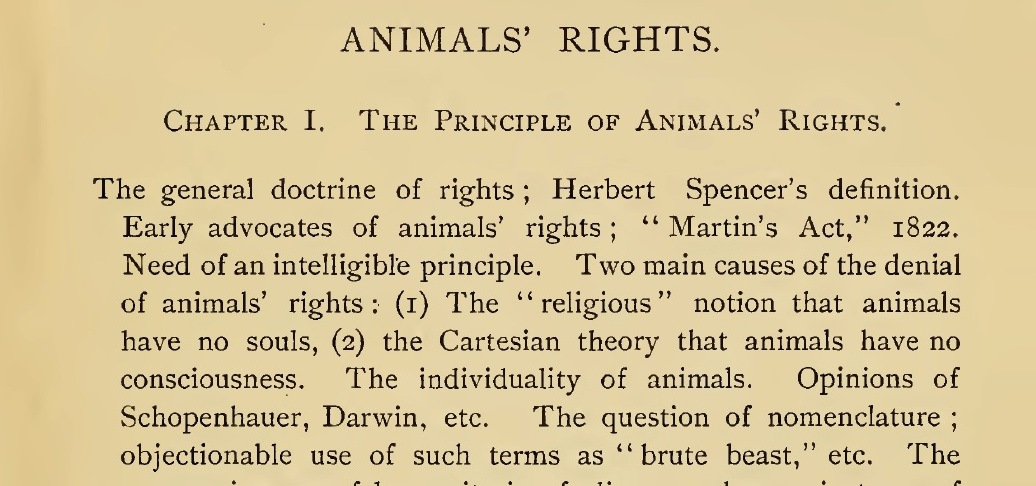‘The emancipation of men from cruelty and injustice will bring with it in due course the emancipation of animals also. The two reforms are inseparably connected, and neither can be fully realised alone.’ (Henry Salt, Seventy Years among the Savages, 1921)
In the beginning there was a Great Chain of beings[i]—presumably.
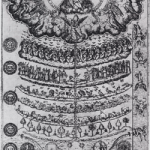
It rattled from Plato through Aristotle to Augustine and Thomas Aquinas, surged through medieval thought and into the modern era. In short, it described a god-ordained, spiritual hierarchy of the universe, descending from God to dirt. The chain was rigidly linear, no double-linking or parallel paths. Man occupied the link between angels and animals—and therefore possessed spiritual as well as physical attributes. Animals, linked to man above and plants underneath, were denied any spiritual attributes. Thus disenfranchised, they found themselves subject to greater and greater demeaning, as subdivisions were installed by Aquinas. Positions were later inserted to classify humans of different ethnicities, social standing, and gender–as was to be expected. A being’s position on the chain was, of course, a product of the chain-maker’s spiritual worldview.
As the great chain wound its way through western thought for millennia, it provided an invisible, institutionalized foundation for several major philosophical viewpoints, upholding Christianity’s pronouncements of man’s holiness, Descartes’ decree of animals as automatons, and various destructive philosophies regarding race.[ii]
Surprisingly, no peace came from all these centuries of rattling chains. However, at times visionary men and women have risen up against all the noise, working to end the oppression inherent in such ancient unrelenting systems.
In this edition of Peace Meal Supper Club™, we are honoring four modern reformers who fought for fairness on multiple fronts, each of whom left indelible marks upon human progress—and irreparably damaged the great chain.
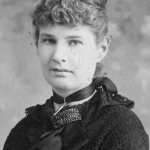
Anna Kingsford (1846-1888), was a British anti-vivisection activist, women’s rights advocate, and vegetarian writer. In 1874, she left her home in London to study medicine in Paris, at Faculté de Médecine, then the leading medical college. She undertook her education specifically to be a better-informed advocate for animals. Her chief concern was the practice of vivisection, which was being championed by contemporary French doctors and researchers.
Among Paris’ medical elite was Dr. Claude Bernard, Europe’s most prominent proponent of vivisection at that time. He was not only its champion, he was its sociopathic romanticist. He wrote: “The physiologist is no ordinary man. He is a learned man, a man possessed and absorbed by a scientific idea. He does not hear the animals’ cries of pain. He is blind to the blood that flows. He sees nothing but his idea, and organisms which conceal from him the secrets he is resolved to discover.”[iii]
Dr. Bernard and most other scientists typically performed vivisection without anesthesia or regard for the animal’s pain. Kingsford wrote of the screams that echoed through the campus, and that she had found her hell within the academy’s halls, “one that fulfills all the dreams of the mediaeval monks.”[iv] Animals were frequently left bound overnight on the tables, simply abandoned after experimentation.
In this atmosphere, and facing extreme prejudice from the all-male faculty, Kingsford completed her degree in 1880. She was only the second woman to become a degreed doctor—and the first person to ever complete the program without performing a single vivisection.[v]
Her final thesis, L’Alimentation Végétale de l’Homme, explored the benefits of vegetarianism. The irony is rich: her thesis had to be approved by the very faculty she came to condemn. Her thesis was later published in English under the title The Perfect Way in Diet. It was widely read and proved to be hugely influential; among its readers was a young Mohandas Gandhi.[vi]
She died at the age of 41, only a few years after receiving her degree. In those years she published several books on diet and spiritualism, traveled a lecture circuit, founded vegetarian societies, spoke out against bull fights, and campaigned for women’s rights—the latter of which she summed up succinctly yet comprehensively: “Equal rights and equal experiences.”[vii] In these words, we can hear the straining of the old hierarchical chain, links distorting as a new order begins to emerge.
Kingsford had a brief tenure as editor of a lady’s periodical, during which time she met our next honoree, Frances Power Cobbe.
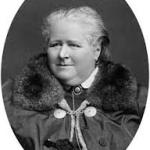
Frances Power Cobbe (1822-1904) is the embodiment of socially progressive reformers during the Victorian era. Born in County Dublin, Ireland, to a prominent family, she was a prolific writer touching on many topics, some dealing with the status of women, others on the science of the day or historical events, and large number dealing with vivisection. She was blessed upon birth with an extremely active mind and a proclivity towards unconventionalism.[viii]
An influential figure in the British Unitarian movement, she could not comprehend God’s care for all of his creation, contrasted with man’s destructive treatment of creation: “If there be one moral offence which more than another seems directly an offence against God, it is this wanton infliction of pain upon his creatures.”[ix]
To her, there was an undeniable link between feminism, animal rights, and vegetarianism, as they all centered upon the rights of all living individuals to possess their own agency.
Among her more prominent activities was the founding of two anti-vivisectionist societies: Society for the Protection of Animals Liable to Vivisection in 1875, and the British Union for the Abolition of Vivisection (BUAV) in 1898. The former was the first organization of its kind; when its governing board began to compromise on vivisection under certain circumstances, she left and began the second organization.[x] Compromise was not a means of progress in her view.
As a women’s rights campaigner she was equally relenting, serving on the executive council of the National Society for Women’s Suffrage in London. She advocated for battered wives, leading to a Parliamentary bill that allowed women to legally separate from abusive husbands. She also pioneered same-sex marriage, entering into a de facto marriage with sculptor Mary Lloyd, which was widely accepted and honored by society.
Her work was comprehensive and tireless, in a world that was very contrary. Her work endured, also: both anti-vivisection groups she founded are still in existence. One of them, the BUAV, is very active internationally in banning the use of animals in testing of products. Products approved by them carry a familiar “leaping bunny” logo.[xi] In addition to lasting work for animals, her work on behalf of women led to lasting reforms, and same-sex marriages are finding acceptance in many countries.
(A harrowing view of the world in which she worked can be seen in accounts of the Brown Dog Affair, a political controversy that raged for seven years in London. A labyrinth of intersectionality and violent oppression, it found medical students rioting in the streets, attacking feminists and anti-vivisectionists as well as police officers. It led to the formation of a Royal Commission to investigate the use of animals in experiments. The Wikipedia article is well worth the read.)
Frances Power Cobbe understood that all humane reforms are tightly connected. All must be pursued as a general program for improving us as humans. We can be better—this is not a judgmental statement; it is one of purpose and direction. Our next protagonist exemplified this in his writings.

Henry Stephens Salt (1851-1939) was an English writer, ethical vegetarian, anti-vivisectionist, pacifist, socialist, and reformer in many fields, including prisons and educational systems. He was a well-regarded classical scholar, conservationist, and literary critic. Salt’s writings influenced Gandhi to embrace vegetarianism. Gandhi was also introduced to the work of Thoreau by Salt.[xii]
Salt has been credited with taking a great step in defense of animals, writing about their rights rather than their welfare. He based this on the fact that the same principles are present when talking about human reforms: “animals, as well as men, though, of course, to a far less extent than men, are possessed of a distinctive individuality, and, therefore, are in justice entitled to live their lives with a due measure of that ‘restricted freedom’ to which Herbert Spencer alludes.”[xiii]
He rejected the notion that there is a fixed separation between man and animals, a “great gulf” that kept them forever separated from justice.
“[The] notion of the life of an animal having ‘no moral purpose,’ belongs to a class of ideas which cannot possibly be accepted by the advanced humanitarian thought of the present day—it is a purely arbitrary assumption…If we are ever going to do justice to the lower races, we must get rid of the antiquated notion of a ‘great gulf’ fixed between them and mankind, and must recognize the common bond of humanity that unites all living beings in one universal brotherhood.”[xiv]
In his book Animals’ Rights in Relation to Social Progress, he addresses the use of animals for food, fashion, sport, and research, posing arguments that are still valid today. Peter Singer, writing in the Preface to the 1980 reprinting, “marvels at how he anticipates almost every point discussed in the contemporary debate over animal rights.” If defenders of animals have added very little to the case Salt outlines, Singer states, they can console themselves because the attackers have come up with few objections that Salt hadn’t already dealt with.
Throughout the book—one of 40 he wrote—his wit and humor shine through.[xv] His was not a bitter pen—he could certainly be acrid when necessary, but compassion is the dominant character of his writing. His sincere desire is for us to create a better humanity, one that is enlightened in its treatment of prisoners, school children, women, domestic animals, wild animals, and even our enemies. It is time for us to take a collective step forward, for the sake of humanity and the world we all inhabit. We cannot be chained down.
“The humane instinct will assuredly continue to develop. And it should be observed that to advocate the rights of animals is far more than to plead for compassion or justice towards the victims of ill-usage: it is not only, and not primarily, for the sake of the victims that we plead, but for the sake of mankind itself. Our true civilization, our race-progress, our humanity (in the best sense of the term) are concerned in this development; it is ourselves, our own vital instincts, that we wrong, when we trample on the rights of the fellow-beings, human or animal, over whom we chance to hold jurisdiction.”[xvi]
Salt extended his work through that of his friends, which included George Bernard Shaw, Rudyard Kipling, Thomas Hardy, Annie Besant, and Leo Tolstoy. Due to his friendship with Gandhi, we find him extending his influence through to Martin Luther King. His pacifist bearing and social ideas have influenced countless people working towards peace. His thoughts on animals’ rights have likewise inspired key individuals, such as Peter Singer, and through him, millions.
Peter Singer credits another writer with sparking his interest in ethical vegetarianism, the English writer Ruth Harrison.
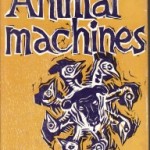
Ruth Harrison (1920-2000), a noted pacifist and conscientious objector during World War II, wrote the first book that exposed to the world the intensive, industrial processes being used to raise food animals in Britain and America. Animal Machines, published in 1964, is a chilling first-hand account of her visits to concentrated animal production facilities, where layer hens, broiler hens, veal calves, rabbits, and pigs were being raised. These systems are best explained by their proponents.
“Rapid turnover, high-density stocking, a high degree of mechanization, a low labour requirement, and efficient conversion of food into saleable products, were the five essentials for a system of animal production to be called intensive.”[xvii]
A system like this necessitates small living spaces—often too small for the animal to turn or lie down—massive application of antibiotics even in the absence of illness, complicit media and government, and a collective disregard for the individuality of animals, all of this “taken to a degree where the animal is not allowed to live before it dies.”[xviii]
It was a system that was coldly calculated to turn living animals into factory cogs, where their job, 24×7, was to produce their own flesh and by-products for our consumption. It was a cheapening of life on every level, from the human consumer through the ‘farmer’ and his small workforce, and certainly of the subject animals. As she drolly notes, “A danger of accepting any form of life as cheap is that each successive generation might accept slightly lower standards.”[xix]
Her expose goes on to prove that very thought, and the theme of “cheap” recurs frequently. But “cheap” now is expensive in the long run, as antibiotic resistance builds in animals and humans, toxicity concentrates in the environment, and the quality of food degrades rapidly.
The biggest casualty, however, is to our humanity: “How far have we the right to take our domination of the animal world—in degrading these animals are we not in fact degrading ourselves?”[xx]
Her question is worthy of intense examination—deeper even than she anticipated. For while she does connect our treatment of animals to our humanity—as did Salt, Cobbe, and Kingsford—she still allows for our domination of them. Though she questions their treatment in the factory, she never questions their presence in the factory. One can almost hear the old chain rattling itself back together.
Her presentation is not without emotion. In fact, she makes pleas throughout the book toward our sense of compassion, asking us if we can really accept such treatment of animals. In her chapter on “Cruelty and Legislation” she approaches us with both rational and emotional demands, and is unrelenting in her call-outs to the Minister of Agriculture as he defends the faulty Protection of Animals Act of 1911. Her efforts did ultimately lead to greater domestic and international protection of animals in industrial confinement, such as the landmark European Convention for the Protection of Animals Kept for Farming Purposes, established in 1976.[xxi]
All humane-oriented reforms of industrial animal agriculture, including roomier battery cages, free-range facilities, and the banning of gestation crates, owe a debt of gratitude to Ruth Harrison. All animal advocates owe her their thanks, in truth. For her detailed and unequivocal reporting of the conditions has informed each one of us. Her tour of the facilities occurred with the consent of the industrialists themselves—something which will not happen in today’s ag-gag environment.
But as I read her book, landmark and influential and vital as it is, I kept hearing that chain lurching back into place. Her pleas ended at humane treatment, never resolving into pleas for release.[xxii] She seems to accept that the chain is in place and that its existence is proper, provided we tidy things up a bit. Something great has been lost—perhaps in more arenas than one.
Oxford professor Chien Hui Li observes that “the two great wars in the first half of the twentieth century and the repressions and reconstructions that followed were low times for social movements in general and animal defence in particular.”[xxiii] As movements gained momentum again, they lost that sense of connection with one another. Further, in the early postwar period, as industrial techniques were being perfected, we were somehow distracted with an illusory return to normalcy.
However, Professor Li’s painting of the context of the animal rights movement presents a strengthening picture. Writing of the reformers such as Salt in the latter 1800s, she says:
“This radical shift of ideologies in reform politics had a direct bearing on the animal cause and offered it opportunities for change. In general, with the new concepts of ‘kinship of life,’ ‘brotherhood,’ ‘equality’ and ‘justice’ brought by evolutionism and socialism, some people began to see animals not as objects of pity, but as having a right to just and fair treatment. Their watchwords now became ‘justice’ and ‘rights,’ no longer ‘mercy’ and ‘kindness.’”[xxiv]
As disruptive as the 20th century might have been to all social progress movements, we still inherited a strong radical shift in thinking. A benchmark has been set, one that never existed before. We still have their foundation to build upon.
“…[F]ar from being marginal and isolated,” states Professor Li, “[the animal rights movement] has always been closely associated with the major literary, religious, and political traditions contributing to the broad development of humanitarianism. Rather than growing at the expense of each other, reform for humans and other animals developed side by side and showed parallel patterns of emergence, consolidation and transformation from eighteenth-century humanitarian sensibility through Victorian philanthropy to political radicalism in the late-nineteenth and again in the late-twentieth centuries. And despite their different tasks and short-term objectives, the two spheres of reform for the most part shared the same ideological origins, cohered in moral vision, and employed similar rhetoric and tactics in their common pursuit of core human values such as charity, equality and justice.”[xxv]
Li offers advice to current activists, which we would all do well to heed:
“While there may be every need for the animal movement to focus on sharply-defined targets in order to achieve short-term goals, there is an equally urgent need to engage with wider literary, religious, scientific, political and other traditions, and to cultivate the state of mind of belonging to much broader social forces striving in the same directions of charity, equality, and justice. This could not only strengthen activists’ faith in something of a deeper nature and broaden their outlook, but also affect the spirit in which their work is undertaken and make it all the more powerful and appealing to others.”[xxvi]
As Salt might describe it, the gem itself is a greater humanity, the facets of which are numerous. We are the honored lapidarians to whom the essential task of rediscovery has been granted.
——
While many labor in fragmented movements, there are some who vigorously utilize the comprehensive approach of Cobbe and Salt. Here are just a few:
lauren Ornelas, the Food Empowerment Project
Dawn Moncrief, A Well Fed World
More on Anna Kingsford:
http://www.henrysalt.co.uk/bibliography/reviews/anna-kingsford
More on Frances Power Cobbe:
http://uudb.org/articles/francespowercobbe.html
Open Library has digitized many of her books and pamphlets: https://openlibrary.org/search?q=frances+power+cobbe
More on Henry Salt:
Many of his writings have also been digitized by Open Library:
https://openlibrary.org/authors/OL833727A/Salt_Henry_Stephens
More on Ruth Harrison:
https://awionline.org/awi-quarterly/2000-fall/tribute-ruth-harrison
The following are from the writings of Henry Salt, and comprise a sample of his witty and adept pen. These have all been borrowed from the website listed above.
The Altruistic Flesh-Eater
(“What would become of Esquimaux?”)
This doubt not: if my choice were free,
A vegetarian strict I’d be.
My heart is in your Cause; but oh!
What, then, of those poor Esquimaux?
I dread to think what might betide them,
If flesh were suddenly denied them;
In Greenland, too, so short of green!
How would they get their Vitamines?
They must have blubber, so, in grief,
(All for their sake) I must have beef.
The Cry of the Might have been
“Sir Leslie Stephen’s remark, that no one is so much interested in the demand for pork as the pig, is surely quite valid.” — DEAN INGE
We are the Pigs Unborn, the Pigs Forsaken;
O’erlooked by heedless folk who eat no bacon.
In blank pre-natal Nothingness we pine,
Robbed of that prerogative of swine,
The born pig’s birthright—to be penned in muck,
In garbage grub, be fatted, and be stuck.
Mere ghosts of porkers, pork we’ll never be:—
This, Vegetarian, this we owe to thee!
O deaf to cry of Pigs that Might have Been,
Art thou not cruel? Ask the learned Dean.
The Sufficient Reason
“A fellow feeling makes one wondrous kind.”
“Be kind to animals,” you’re told.
The reasons? Well, they’re manifold,
And some are new, and some are old;
But when all’s said and done,
The motive that you’ll find most strong,
The simple rule, the short-and-long,
For doing animals no wrong,
Is this – that “you are one.”
“I am aware that many of my contentions will appear very ridiculous to those who view the subject from a contrary standpoint, and regard the lower animals as created solely for the pleasure and advantage of man; on the other hand, I have myself derived an unfailing fund of amusement from a rather extensive study of our adversaries’ reasoning.” – in the Preface to Animals’ Rights Considered in Relation to Social Progress
“We must meet this ridicule [of the animal rights movement] and retort it without hesitation on those to whom it properly pertains. The laugh must be turned against the true ‘cranks’ and ‘crotchet-mongers’—the noodles who can give no wiser reason for the infliction of suffering on animals than that it is ‘better for the animals themselves.’”—Animals’ Rights, Chapter VIII, page 123
—
[i] http://en.wikipedia.org/wiki/Great_chain_of_being
[ii] http://www.pbs.org/race/000_About/002_04-background-02-09.htm
[iii] http://en.wikipedia.org/wiki/Claude_Bernard
[iv] Rudacille, Deborah. The Scalpel and the Butterfly. University of California Press, 2000; pg. 35
[v] Ibid, pg. 31
[vi] Stuart, Tristram. The Bloodless Revolution, Norton, 2006; pg. 424
[vii] http://www.henrysalt.co.uk/bibliography/reviews/anna-kingsford
[viii] http://uudb.org/articles/francespowercobbe.html
[ix] http://www.animalrightshistory.org/animal-rights-c1837-1901/victorian-c/cob-frances-power-cobbe/1863-man-beasts.htm
[x] http://en.wikipedia.org/wiki/National_Anti-Vivisection_Society
[xii] http://www.henrysalt.co.uk/
[xiii] Salt, Henry. Animals’ Rights Considered in Relation to Social Progress, 1894; pg. 9
[xiv] Ibid; pg. 10
[xv] See selections below the article for examples of his charming and snarky wit.
[xvi] Animals’ Rights; pg. 110
[xvii] Harrison, Ruth. Animal Machines, 1964; pg. 35. She is quoting from Farmer and Stockbreeder, 19 December 1961)
[xviii] Ibid; pg. 37
[xix] Ibid; pg. 37
[xx] Ibid; pg. 114. The italics are hers.
[xxi] https://awionline.org/awi-quarterly/2000-fall/tribute-ruth-harrison
[xxii] The organization she founded in 1967, Farm Animal Care Trust, continues to educate only about animals in the system. They do not advocate release from the system. http://www.fact.uk.com/index.html
[xxiii] http://www.historyandpolicy.org/policy-papers/papers/the-animal-cause-and-its-greater-traditions
[xxiv] Ibid.
[xxv] Ibid.
[xxvi] Ibid. Really, read the entire article by Professor Li. It is very encouraging.
